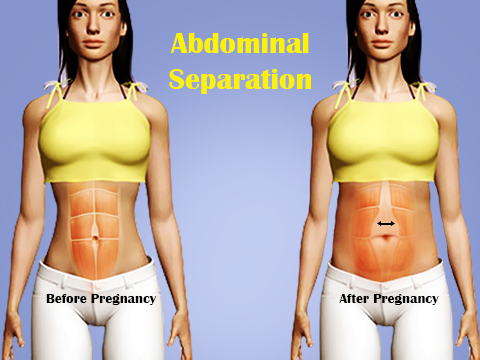
Diastasis recti is otherwise known as abdominal separation. It is generally defined as a gap of nearly 2.7 cm or greater between the two sides of the rectus abdominal muscle. This not a fatal condition but is quite a common condition. In this condition, the right and left halves of the abdomen muscle spread apart at the body’s midline fascia, the linea alba. This widening and the thinning of the midline tissue happens due to the pressure of the uterus pushing against the abdominal wall. At the same time, the tissue becomes soft due to the pregnancy hormones. If the gap is more than 2 centimetres, it becomes problematic. This condition can happen anytime in the last half of pregnancy but is usually seen after delivery. At this stage the abdominal wall is relaxed, and the midline tissue no longer provides adequate support for the torso and internal organs. It is normal for a small gap or widening of the midline during all pregnancies. Diastasis recti occurs in about 30% of all pregnancies. For some women, this gap closes postpartum spontaneously, but for others, the gap remains too wide and causes problems. Diastasis recti can also be seen in infants and adults with excessive abdominal visceral fat.

Several issues like aggravated lower back pain and pelvic instability happen due to Diastasis recti as it reduces the integrity and strength of the abdominal wall. A prior history of separation in previous pregnancy significantly increases the probability, and severity, of the condition in subsequent pregnancies. Other factors such as women pregnant with more than one baby, women who are small, those with any spinal issues, or with poor abdominal muscle tone are at greater risk. Genetics also plays a big role. For some women, it is only how their bodies respond to pregnancy.
There are a lot of myths, beliefs and theories about this condition. There are weird and unreasonable suggestions and advice that are given to pregnant women regarding this condition and about the ways to correct it. Some of these can actually worsen diastasis recti/abdominal separation.
This simple self-test will help you determine if you have diastasis recti. Rest on your back. Make sure that your knees bent, and the soles of your feet are on the floor.Keep one hand behind your head, and the other on your abdomen, with your fingertips over your midline-parallel with your waistline (to be perfect: at the level of your belly button). Gently press your fingertips into your abdomen with your abdominal wall relaxed .Roll your upper body away from the floor into a “crunch,” making certain that your ribcage moves closer to your pelvis.Move your fingertips back and forth over your midline, feeling for the right and left sides of your rectus abdominis muscle. Test for separation at, above, and beneath your belly button.


As mentioned before, in most cases of diastasis recti, the gap will close by itself after child birth. However difficult cases may cause umbilical hernia and need surgery to correct the same. There are exercises you can do to help correct this condition, and even help prevent it.

Exercises can help a to prevent or lessen the severity of diastasis recti by strengthening the deepest abdominal muscle, your Transverse Abdominis, or TvA. This is the body’s internal “girdle” and when this is contracted, it compresses the abdominal wall. All pregnant women should perform basic TvA exercises throughout their pregnancies to help prevent diastasis recti as well as back pain and Pelvic instability. As a bonus, because the TvA is our body’s major expulsion muscle, building and maintaining strength here greatly aids in the pushing phase of labour. Nonetheless, the following exercises are often suggested to help build abdominal strength. Core contraction, seated squeeze, head lift, upright push-up, squat against the wall, squat with a squeeze, mini-crunches, leg extensions and plank.
It is also noted that incorrect exercises, including crunches, can actually increase the diastasis recti separation. All corrective exercises must be in the form of pulling in of the abdominal muscles than a pushing of them outwards. Consultation of a professional physiotherapist is suggested for correct exercise routines.
It is the most powerful creation to have life growing inside of you.There is no bigger gift